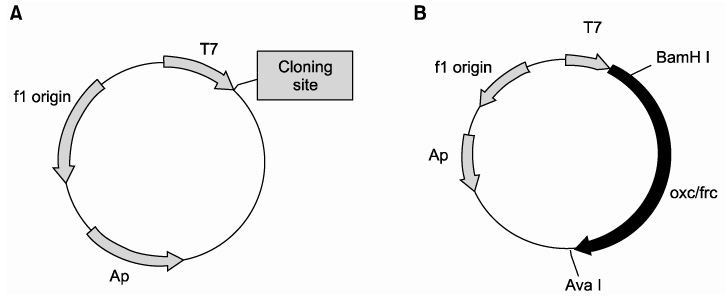Korean J Urol.
2007 Feb;48(2):206-211. 10.4111/kju.2007.48.2.206.
Development of Recombinant Escherichia coli expressing oxc and frc Gene of Oxalobacter formigenes
- Affiliations
-
- 1Department of Urology, Seoul National University College of Medicine and Clinical Research Institute, Seoul National University Hospital, Seoul, Korea. hhkim@snu.ac.kr
- 2Department of Laboratory Medicine, Seoul National University College of Medicine and Clinical Research Institute, Seoul National University Hospital, Seoul, Korea.
- KMID: 2139762
- DOI: http://doi.org/10.4111/kju.2007.48.2.206
Abstract
-
PURPOSE: Oxalobacter formigenes (O. formigenes) is an obligate anaerobe, which may be important in the prevention of stone formation. O. formigenes degrades oxalates using oxalyl-CoA decarboxylase and formyl- CoA transferase encoded by the oxc and frc genes, respectively. Attempts were made to develop recombinant Escherichia coli (E. coli) expressing both the oxc and frc genes of O. formigenenes.
MATERIALS AND METHODS
After the extraction of total RNA from O. formigenes, a reverse transcriptase-polymerase chain reaction (RT-PCR) was carried out using primers synthesized according to the oxc and frc genes reported in GenBank. The cloned cDNA encoding oxalyl-CoA decarboxylase and formyl-CoA transferase was introduced into the pET-22b (+) plasmid vector. The constructs were verified by restriction analysis and DNA sequencing. The plasmid vector containing the cDNA fragment was transformed into competent E. coli BL21 (DE3). The recombinant E. coli was then analyzed using SD-SPAGE for the protein expressions of oxc and frc gene products, and visualized by staining with Coomassie Blue.
RESULTS
Restriction enzyme and sequence analyses showed the gene cloned into the pET-22b (+) plasmid vector was identical to the reported oxc and frc genes. After the transformation into the competent E. coli, the SDS-PAGE analysis showed the recombinant E. coli expressed the proteins migrating at 66 and 50KD, which was identical to the reported weight of oxalyl-CoA decarboxylase and formyl-CoA transferase. CONCLISIONS: A recombinant E. coli, expressing oxc and frc genes, was successfully produced. Further studies may be necessary to investigate their enzymatic activities on the degradation of oxalate in the development of a new therapeutic strategy for the prevention of stone formation.
MeSH Terms
Figure
Reference
-
1. Ahlstrand C, Tiselius HG. Recurrences during a 10-year follow-up after first renal stone episode. Urol Res. 1990. 18:397–399.2. Scheid CR, Koul H, Hill WA. Coe FL, Favus MJ, Pak CY, Parks JH, Preminger GM, editors. Oxalate ion and calcium oxalate crystal interactions with renal epithelial cells. Kidney stones: medical and surgical management. 1996. Philadelphia: Lippincott-Raven;129–143.3. Allison MJ, Dawson KA, Mayberry WR, Foss JG. Oxalobacter formigenes gen nov., sp. Nov.,: oxalate degrading anaerobes that inhibit the gastrointestinal tract. Arch Microbiol. 1985. 141:1–7.4. Kim HH, Jo MK, Kwak C, Park SK, Yoo KY, Kang DH, et al. Prevalence and epidemiologic characteristics of urolithiasis in Seoul, Korea. Urology. 2002. 59:517–521.5. Byeon SS, Kim HH, Kim SH. Analysis of the urinary stone components using chemical analysis method. Korean J Urol. 1996. 37:179–186.6. Uribarri J, Oh MS, Carroll HJ. The first kidney stone. Ann Intern Med. 1989. 111:1006–1009.7. Finlayson B, Khan SR, Hackett RL. Mechanism of stone formation. An overview. Scan Electron Microsc. 1984. 3:1419–1425.8. Doane LA, Liebman M, Caldwell DR. Microbial oxalate degradation; effects on oxalate and calcium balance in humans. Nutr Res. 1989. 9:957–964.9. Lung HY, Baetz AL, Peck AB. Molecular cloning, DNA sequence, and gene expression of the oxalyl-coenzyme A decarboxylase gene, oxc, from the bacterium Oxalobacter formigenes. J Bacteriol. 1994. 176:2468–2472.10. Sidhu H, Holmes RP, Allison MJ, Peck AB. Direct quantification of the enteric bacterium Oxalobacter formigenes in human fecal samples by quantitative competitive-template PCR. J Clin Microbiol. 1999. 37:1503–1509.11. Kwak C, Jeong BC, Lee JH, Kim HK, Kim EC, Kim HH. Molecular identification of Oxalobacter formigenes with the polymerase chain reaction in fresh or frozen fecal samples. BJU Int. 2001. 88:627–632.12. Kwak C, Kim HK, Kim EC, Choi MS, Kim HH. Urinary oxalate levels and the enteric bacterium Oxalobacter formigenes in patients with calcium oxalate urolithiasis. Eur Urol. 2003. 44:475–481.13. Sidhu H, Allison MJ, Chow JM, Clark A, Peck AB. Rapid reversal of hyperoxaluria in a rat model after probiotic administration of Oxalobacter formigenes. J Urol. 2001. 166:1487–1491.14. Kwak C, Oh JE, Kim HK, Choi MS, Kim EC, Kim HH. Isolation and purification of the oxalate-degrading bacterium Oxalobacter formigenes in human feces. Korean J Urol. 2003. 44:785–790.15. Anantharam V, Allison MJ, Maloney PC. Oxalate: formate exchange. The basis for energy coupling in Oxalobacter. J Biol Chem. 1989. 264:7244–7250.16. Sidhu H, Ogden SD, Lung HY, Luttge BG, Baetz AL, Peck AB. DNA sequencing and expression of the formyl coenzyme A transferase gene, frc, from Oxalobacter formigenes. J Bacteriol. 1997. 179:3378–3381.
- Full Text Links
- Actions
-
Cited
- CITED
-
- Close
- Share
- Similar articles
-
- Molecular Identification of Oxalobacter formigenes with Polymerase Chain Reaction: Fresh vs. Frozen Stool
- Molecular Epidemiology of Fecal Oxalobacter formigenes in Healthy Adults Living in Seoul, Using a Polymerase Chain Reaction-Based Detection System
- Isolation and Purification of the Oxalate-Degrading Bacterium Oxalobacter formigenes in Human Feces
- Correlation between Urinary Oxalate Levels and Enteric Oxalobacter formigenes in Patients with Calcium Oxalate Urolithiasis
- Construction of a Mycobacterium - Escherichia coli Shuttle Vector and Use in the Expression of Foreign Genes in Mycobacteria






